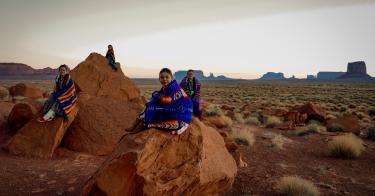Three thousand and one hundred feet. That’s the distance between Hilltop Christian School in New Mexico and the Arizona border—but for students in the Navajo Nation, it might as well be 3,100 miles.
A change in policy by the state Department of Education means Navajo Nation students living on the Arizona side are no longer allowed to use education savings accounts to pay tuition at Hilltop. With an account, the state deposits a portion of a child’s funds from the state education formula into a private account that parents use to buy products and services for their children, including private school tuition.
Tim Sandefur, vice president of the Goldwater Institute, measured the 3,100-foot distance and sent a letter to the agency on behalf of these Navajo families asking the department to withdraw the policy.
For more than two years, Navajo families have been using the accounts to send their children to Hilltop. But the state Department of Education is now denying students access to this school because it sits across state lines in New Mexico. It’s even telling parents to repay money already spent on tuition.
Arizona law already says account holders can use the accounts to pay for online schools headquartered anywhere in the U.S., as well as tuition at any private college in the country. Sandefur explains that state law also “allows parents to pay for ‘teaching services’ from authorized individuals or facilities regardless of where they’re located.”
The goal of education savings accounts is to help children and their chances of success in school, and for that matter, in life. That is far more important than forcing students to attend a K-12 school in Arizona.
Even the Arizona law says the purpose of education savings accounts is to “provide options for the education of students in this state.” So how does taking away an option for some of the nation’s lowest-performing students further this goal?
Native American students have the lowest high school graduation rate of any ethnic subgroup in the country. Eighty percent of Native American fourth graders read at or below what a national comparison considers a “basic” level. By comparison, nearly the same proportion of white students score at or above the basic level (79%).
In Arizona, Native American students graduate at nearly the same rate as children with special needs. These students have the highest dropout rate of any subgroup—a rate that is double the same figure for their white peers.
Arizona’s education savings accounts had offered hope to Native American students. For instance, St. Michael Indian School in Window Rock, Arizona, located on the Navajo Reservation, reports that 99% of students graduate and 98% attend college.
Shortly after Arizona became the first state to offer education savings accounts to students, surveys found high levels of satisfaction among account holders. Yet a survey released last week found this figure has slipped in recent years.
Those looking to explain the discontent should start with agency rules like the new limits for Navajo students.
The Goldwater Institute’s recent letter challenging the agency’s new interpretation of state law isn’t the first such correspondence. Two years ago, the Arizona Department of Education reversed course on nearly a dozen new provisions it had issued after a letter pointed out that the department had exceeded its authority.
National research suggests that state regulations can limit parental options by scaring off private schools from even participating in state programs. Research from Louisiana and elsewhere have found that school leaders think twice about participating in education opportunities, such as K-12 private school scholarships, that operate with rules to micromanage private schools.
Arizona lawmakers say they will introduce a proposal to clarify that Navajo students can access quality learning options, even across state lines. But the solution can’t come quickly enough. Posts on social media indicate the state superintendent, Kathy Hoffman, wants to resolve the issue, too—though it’s not clear when or how learning options will be restored for the Navajo students.
Education savings accounts are a glimmer of hope for these children, and officials should ask themselves why these options for Navajo students were rescinded in the first place.
This piece originally appeared in The Daily Signal




